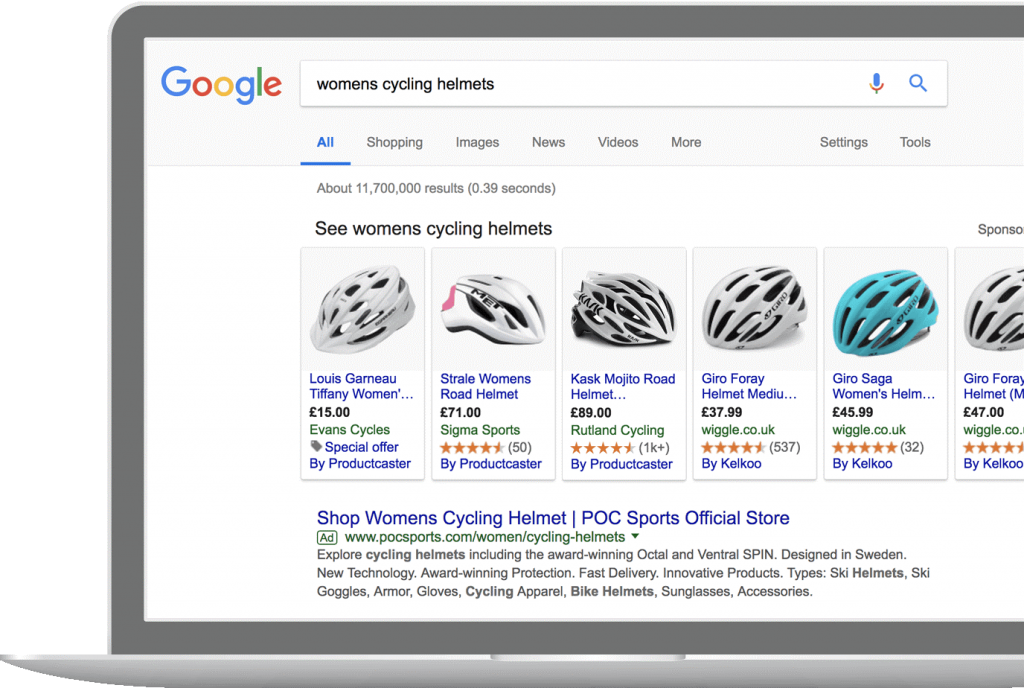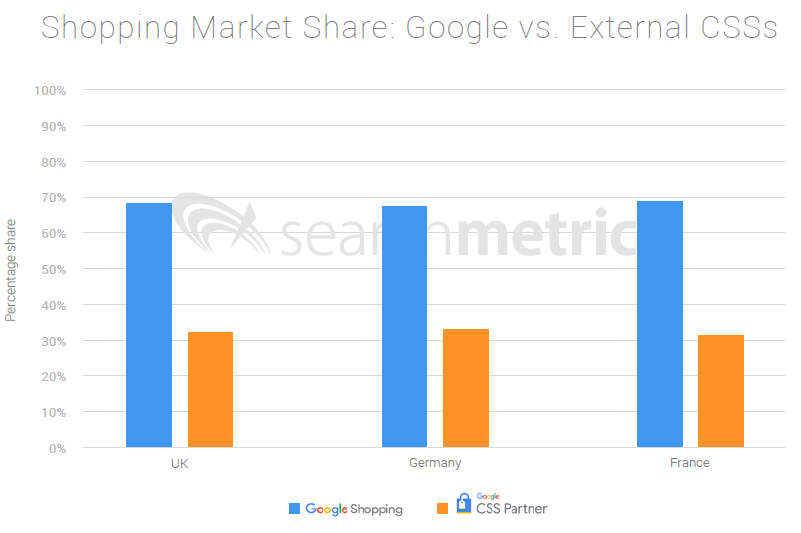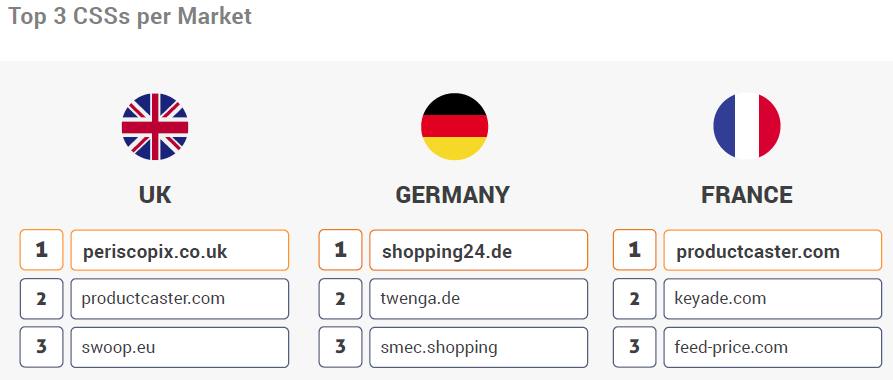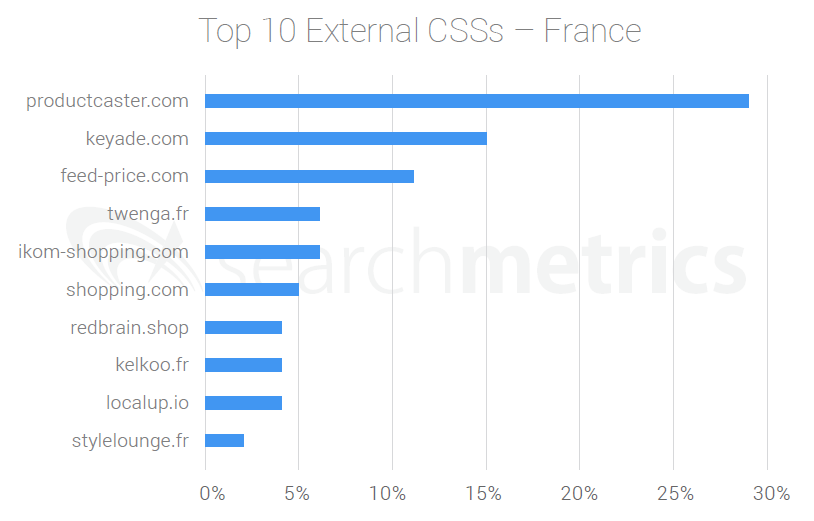In 2018 Summit built their proprietary technology Productcaster, giving clients access to the Google Shopping auction for up to 20% less cost than their competitors who are not making the most of having a Comparison Shopping Service (CSS).
Why did we build Productcaster CSS?
Productcaster was developed by Summit in answer to the antitrust ruling from the European Union against Google in 2017, which meant that Google could no longer monopolise the Comparison Shopping space, enabling alternatives to Google Shopping to appear in the Product Listing Ad (PLA) results. Within the first 6 months of the CSS programme launch, Productcaster established itself as the largest CSS partner in Europe and we have maintained this and our ‘Premium’ status ever since.
What is the incentive for using a CSS partner?
To incentivise retailers to work with CSS partners, Google removed their cut of the cost of a Shopping Click for those who partner up with an alternative CSS. This means that savvy retailers are saving up to 20% on their Google Shopping spend. For every £1 spent through Google Shopping directly, only around £0.80p is being spent on your click, while £0.20p is going towards Google’s ‘Hosting Fee’. When working with Productcaster, your full £1 is being invested: without spending any more, you are unlocking improved performance. In the current economic climate, any cost saving that can be found is crucial to retailer survival.
Given the ultra-competitive nature of the Google Shopping auction, any advantage you can gain over your competitors is essential. Even if all your competitors are already using a third-party CSS partner while you are not, finding a partner will help you in levelling the playing field: regardless of the CSS crowding situation in your vertical, having a CSS partner will benefit you.
Which commercial model is best for you?
When choosing a CSS partner, there are different commercial and support models you need to consider, Productcaster offers the following on a fixed monthly fee basis:
- SaaS: access to the CPC savings.
- SaaS +: access to the CPC savings, reporting and troubleshooting
- Premium: access to the CPC savings and strategic support
We have created these different levels of support to ensure that we are meeting your service and commercial expectations.
With Productcaster, you will not have to change your current set up: you keep control of your campaigns in the same interfaces you currently use and the only change you see is under your Google Shopping ads which will go from ‘by Google’ to ‘by Productcaster’.
If you would like to start taking advantage of the CSS advantages, please get in touch by email info@productcaster.com or phone +44 (0)20 3948 4696.
[et_pb_section admin_label="section"]
[et_pb_row admin_label="row"]
[et_pb_column type="4_4"]
[et_pb_text admin_label="Text"]
The Current CSS Landscape
Comparison Shopping Services (CSS) have created plenty of noise in the online retail space during 2018. Whether an agency, retailer or consumer, most have encountered the change in the Google Shopping market through seeking the reward incentives for their own financial gain or have discovered through plain curiosity in the way the text under the adverts now look.

For those who require a refresher, Google was hit with a 2.4 billion euro fine back in June 2017 and the market was challenged to drastically evolve to enable more competition and provide other CSS providers better access to the Google Shopping market. Retailers and agencies could continue to place their ads via Google or access the incentivised programme via another CSS such as Productcaster. As well as gaining a saving of up to 20% on Cost Per Click (CPC) activity, Google also introduced an incentive programme, SpendMatch, that rebates online merchants up to 30% of their shopping ad budget as cashback.
Google Shopping: Analysis and Market Overview
Global search and online visibility experts, Searchmetrics, analysed the current market situation around Google Shopping following their initial report back in January 2018. They specifically viewed the change in landscape in the UK and Germany, analysing what impact CSS had on the shopping market, how the proportion of Google ads vs. competitor ads had changed, and which product comparison pages were most frequently found in the shopping units. The most recent report also analysed the French market.
Using their expertise, they analysed a robust keyword set and reviewed each of the three Google indexes on four separate dates in autumn 2018.
The Findings
Although the market has changed, as expected Google themselves are still heavily present in all three markets analysed. The graph below also indicates around a third of shopping ads are provided by competitor CSSs, with Google Shopping still maintaining two thirds of the market in the UK, Germany and France.

In the January 2018 report, which analysed only the UK and German markets, the study found that CSSs were majorly unrepresented in the Product Listing Ads (PLAs). In the UK only 0.4%, and in Germany only 2%, occupied the prime shopping spots. Fast forward to present day and what is evident is the large increase with 32% visibility in the UK, 33% in Germany, and for the first time analysed, France with 31%.

When it came to looking at who was taking a lead out of all 132 Google CSS Partners (as of 12th December 2018) in the three markets, Productcaster appears more than any other CSS, topping the board in France and coming a close second in the UK.

The UK displays the largest CSS diversity of all three markets, with the top four competitors owning at least 10% of all CSS ads, compared to Germany and France where only three competitors own 10%.
Over in France, Productcaster dominates the market with almost double the amount of CSS ads of its nearest competitor at 29%. “Traditional” price comparison sites such as Kelkoo and Twenga, although present, do not have the same substantial impression share.

What’s Next for CSS?
Over the last 12 months the most significant change is the number and diversity of CSS appearing in Google Shopping. Productcaster’s own research has shown an increase week on week since our tracking in early July, when only 36 CSS partners were live, in comparison to the 132 live in December today.
However, Google announced this week that, as of the 31st January 2019, the requirements for the CSS program will change. All sites must meet the following criteria to continue to participate in Shopping ads:
The CSS website must offer sorting or filtering options of product search results by price and at least one other dimension that is relevant for consumers (for example brand, merchant, shipping time).
CSS sites must show offers from at least 50 distinct merchant domains for every country in which they target Shopping ads. CSSs will be asked to self-certify by January 31, 2019 that they have offers from at least 50 distinct merchant domains per country on their site (Google will be providing a tool for self-certification in late January). These must be merchants that ship products to the respective country, meaning consumers in that country can buy from them. Google will conduct checks and may ask CSSs to provide evidence that they meet this requirement.
What does this mean for the market as we head into 2019? The market will continue to consolidate, and the CPCs will likely to become more competitive as a result. It is therefore more important now than ever to choose a CSS partner whom focuses on serving the customer first but one that also continuously develops through times of change.
You can read more about the report and download Searchmetrics Google Shopping 2018 on their blog.
[/et_pb_text]
[/et_pb_column]
[/et_pb_row]
[/et_pb_section]
On the 12th December 2018 Google announced there will be changes to the criteria for Comparison Shopping Service (CSS) partners which take effect from 31st January 2019.
At Productcaster, we have already noticed that there is a shake-up in the market, with brands questioning whether their CSS partner will make the grade by the end of January. CSS partners in turn are trying to understand whether they should continue or seek alternative support for their existing clients, due to the ongoing costs in developing and maintaining their solution.
The key requirements that partners need to fulfil include the following:
- A Google CSS partner needs 100 merchants
- A premium CSS partner needs 500 merchants
- All partners need 50 merchants per country where shopping offers are displayed
As a leading Premium Google CSS partner, we are committed to maintaining our CSS partner status. Rest assured, we will not be disappearing as a CSS Premium Partner. We will continue to scale our solution with our dedicated CSS team supporting with onboarding, performance management and the development of our best in class CSS platform.
At Productcaster we offer:
- Transparent fixed fee commercials terms that will work for retailers and agencies
- Seamless and hassle-free migration managed by Productcaster
- Access to CSS Google team to support as required
- Regular releases to our platform and the opportunity to feed into our future development
- Performance Measurement Framework to ensure the benefits are aligned to your objectives
- User friendly comparison site that represents retailers’ brands in a professional way
- Dedicated multi-lingual specialist CSS team to answer all your questions
Productcaster has a Feefo 5-star rating, as scored by our customers for service.
Whether you are a brand or an agency, if you are interested in understanding how we can support you through these changing times, please contact our specialist CSS team for more information on +44 (0)203 910 7026 or email cssteam@productcaster.com.
You can also read more about the imminent Google CSS partner changes here: https://support.google.com/merchants/answer/7524491?hl=en-GB
Calling all agencies and retailers! Do you want to know how to maximise ROI from Google Shopping this peak and beyond?
It’s not too late; watch the replay of our 45-minute webinar to find out how you can do exactly that.
The webinar was hosted by Commercial Director of Productcaster, John Readman, and Dave Trolle, Managing Director of Marketing Technology. We were joined by Jeff Mainwood, Head of Performance Marketing at Productcaster client Sigma Sports, and Peter Whitmarsh, Head of Paid Media at Search Laboratory.

Here’s what the webinar will cover.
Google Shopping CSS if for life, not just for Christmas
At Productcaster, we have helped online retailers benefit from and save with our comparison shopping service. Working with established brands such as Argos, Joules, Durex and more, we understand the importance of Google Shopping Comparison Shopping Services (CSS) all year round. Although peak is the prime time to get on board with Google Shopping CSS, it is certainly for life, and not just for Christmas.
We know that peak time is fast approaching, however, it’s not too late to start benefiting from Google Shopping CSS. Watch the webinar replay to learn about how to save and improve your ROI from Google Shopping this Christmas and beyond, as well as how to take advantage of the Google SpendMatch incentive before it ends.
Choosing the right partner to protect your brand or your customer’s brand
With first-hand knowledge from both a retailer and agency side, discover top tips and insight about how to choose the right CSS partner that will protect your band, or your client’s brand.
This is an essential step that you must get right in order to maximise ROI from Google Shopping. In the webinar replay, you’ll be able to understand our top five tips for choosing the perfect CSS partner.
Client and agency success stories revealed
All this talk of CSS and Google Shopping savings is well and good, but where’s the proof?
In our webinar, we pulled back the curtain and shared the stories of how some of our clients have improved their ROI from Google Shopping advertising. Listen to the real-life studies that have helped brands improve their Google Shopping strategy to drive success.
First, Jeff Mainwood, Head of Performance Media at Sigma Sports, shared some key insights and successes that Sigma Sports has seen since partnering with Productcaster.
Peter Whitmarsh, Head of Paid Media at one of our agency partners, Search Laboratory, then talked about why he chose to work with Productcaster over other CSS partners. He also shared some insights and results that Search Laboratory has seen across its client portfolio since migrating campaigns to the Productcaster platform.
Q&A and online debate with peers and industry specialists
At the end of the webinar, we rounded up some of the questions that came in from attendees throughout. These triggered a lively discussion around key CSS and Google Shopping advertising-related themes, including:
- Should bidding be kept at the same level after moving to a CSS Partner?
- How much traffic comes through the Google Shopping tab, as opposed to the main search results page?
- Have clients seen any traffic or conversions from the Productcaster listings?
- Is CSS just a way around the EU antitrust ruling against Google?
- Will there be future CSS discounts available in January and beyond?
- Do campaign parameters remain the same within Google Analytics, Google Ads and the Merchant Centre when you onboard with Productcaster?
- Are Google raising the bar for CSS?
- How are accounts managed and what kind of support does Productcaster provide?
Click here to watch the webinar replay.
Many retailers with digital channels recognise the value in Google Shopping as a cost effective way of getting products in front of consumers and driving growth. However, the platform has become a victim of its own success by incurring a heavy antitrust fine from the EU last year over the lack of competition on the site.
In order to rectify the situation, Google has introduced favourable CPC rates to advertisers who use the updated Comparison Shopping Service (CSS) format to display their Google Shopping adverts.
Productcaster, a Google Comparison Shopping Partner, has already seen positive results for retail clients around Europe with CPC saving ranging from 15-25% of Google media spend. Advertisers are also able to take advantage of an additional ad credit offered by Google of up to €32,000 every 30 days based on a spend match against ad spend. While some retailers are using the saving to cut costs while maintaining click-throughs, others are kept spend levels consistent while generating further growth.
Migration to the new ad format is straightforward, requiring no changes to existing Adwords campaigns with advertisers maintaining full control of their Google accounts.
From speaking with Managing Director of IMRG, Justin Opie, it is clear that the savings to be had through this new retail offering from Google are significant given that IMRG data shows that on a last-click attribution basis, paid media on average accounts for around 20% of the online retail revenue that is derived from all marketing channels. Justin told us that “with the current uncertainty facing retail, we anticipate retailers to be interested in any opportunity to increase their ROI from their marketing channels.”
Additionally, Productcaster is offering one month free for IMRG members that sign up before 30.09.18. To qualify for this offer, please confirm your IMRG membership when you first contact us to discuss how we can reduce your Google spend.
Following the EU antitrust ruling last year, Google created a programme for comparison shopping sites such as Kelkoo to appear in the general search results page from September 2017. The objective of this initiative is to increase the competition in Google’s shopping ad space so that users don’t just experience ads just ‘by Google’.
Google have confirmed that they are offering favourable CPC rates to advertisers who use the new Comparison Shopping format. Advertisers are expected to see between a 15-20% reduction in their CPCs from the same position in the Shopping results. To encourage advertisers Google are also offering an ad credit of up to 32k Euros every 30 days based on a spend match against an advertisers spend each month using the new Comparison Site format.
Clearly, Google are under pressure by the EU Commission to make positive traction in improving the impression share of alternative shopping comparison sites in the general search results page. This initiative should be highly attractive to advertisers who for once are seeing a potential reduction in their media costs on Google. A growing number of EU retailers are now waking up to this lucrative opportunity including Sainsburys Argos in the UK.
Despite ongoing complaints from Google’s European shopping rivals, the European Commission chief said the changes Google has made appear to be working. European Competition Commissioner Margrethe Vestager is quoted by Reuters explaining that rivals now have greater visibility in search results and there are more clicks being driven to their sites.
While Vestager cautioned that “It’s still too early to draw conclusions,” she observed:
We know from our monitoring there’s been a steady increase in the numbers over the last few months. The most recent figures show at least one rival appears in about one-third of new shopping boxes as compared to 15 percent of the shopping boxes back in March . . . Similarly the share of clicks of products of rivals in Google shopping boxes also increased from 2.5 percent in February to 6.1 percent now.
The Google Shopping changes came in the wake of a record €2.4 billion ($2.8 billion) penalty, which Google is appealing. Google has also suggested in the past that the performance of its shopping search rivals is partly a product of poor user experiences on some of those sites.
Commissioner Vestager’s remarks to the European Parliament were a rare statement of support for the search engine. She has been persistently critical of Google and its market position since taking office. However, because of Danish internal politics, she may not be reappointed to a second term in 2019. A new Competition chief could change the dynamics of antitrust enforcement in Europe.
Google parent Alphabet faces two more potential antitrust penalties, surrounding Android and AdWords agreements. In addition, Yelp has asked for a new formal Statement of Objections(antitrust charges) against the company in local search. That complaint follows the logic of the earlier shopping search complaint that led to the penalty and remedial measures.
Notwithstanding the qualified support from Vestager, a June 6 report in Financial Times (paywall), says that the European Commission is ready to impose a second major antitrust fine over Android and the issue of OEM requirements that Google apps be pre-installed for those using the Google Play store.
This article was kindly reproduced from Search Engine Land
In response to the European Commission’s antitrust ruling — and record $2.7 billion fine — against Google for favoring its own content, the search giant is making some changes to the way it handles Google Shopping results in the EU.
Starting today, Comparison Shopping Engines/Services (CSEs) such as Kelkoo, Shopzilla and Twenga will be able to run product listing ads in Google Shopping results as retailers do so currently.
The EC’s ruling required Google to deliver a solution to provide “equal treatment” to CSEs within 90 days or face further penalties. That deadline has now arrived. The EC doesn’t have a specific approval process, but Google believes the changes it’s making put it in compliance with the order.
How is the auction changing?
The biggest change isn’t in how the results are displayed but in who competes in the auction.
CSE’s will compete in the auction against each other — and against Google Shopping.
As was previously reported, Google Shopping will operate as a separate business unit with a separate team in the EU that will be responsible for its own operating budget. It must operate profitably and will be reviewed regularly by the Commission to ensure the unit is competing on equal terms.
All of the ad slots will be available to all bidders; no ad slots are reserved for either Google Shopping or CSEs.
This brings up several questions about how this will actually play out for merchants now that Google Shopping and the CSEs are in effect bidding on their behalf.
A good percentage of merchants are likely participating in Google Shopping and at least one or more CSE. The visibility in Google Shopping will now depend, not just on the merchant’s own bid and quality metrics, but on how well it performs for Google Shopping and the CSEs for a given query. Google’s bids will have to make sense for it as a marketer, just as they do for CSEs.
How this new bidding dynamic will affect merchants’ own bidding strategies will be interesting to watch.
We have learned that there are controls in place to keep merchants that are running ads through Google Shopping and through participating CSEs from bidding against themselves for a given query.
How are the shopping ad results changing?
As the example above shows, ads will appear with the name of the service that is serving up the ad — either Google or a CSE.
The ads themselves each link to the product page on the retailer’s site, just as they do now.
Clicking on “By Kelkoo” or “By Google,” for example, takes the user to the product results on the given engine. There is no longer a “Shop for … on Google” link a the top of the shopping results.
What else do you need to know about this update?
- It only affects results in EU countries where Google Shopping is available: Austria, Belgium, Czech Republic, Denmark, Germany, France, Italy, Ireland, the Netherlands, Norway, Poland, Portugal, Spain, Sweden, Switzerland and the United Kingdom.
- A handful of CSEs have been testing the new offering and are queued up to start showing ads now. Other CSEs can get started with the service today.
- CSEs upload their product feeds to Google Merchant Center just as retailers do now.
- CSE feeds are held to the same data requirements as retailer feeds.
Google is continuing its appeal of the EC ruling. That appeal process could take years.


